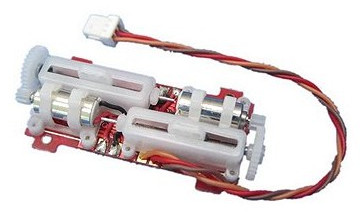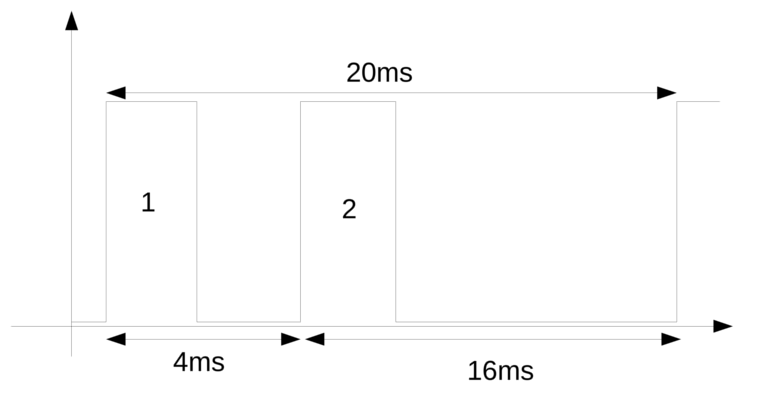Difference between revisions of "Subsystem/actuators"
IHaveADrone (talk | contribs) (anchor tag links and spelling) |
|||
| Line 3: | Line 3: | ||
Currently possible actuators subsystems are | Currently possible actuators subsystems are | ||
* ''mkk'' | * ''[[Subsystem/actuators#MKK|mkk]]'' | ||
* ''asctec'' | * ''[[Subsystem/actuators#MKK_v2|mkk_v2]]'' | ||
* ''asctec_v2'' | * ''[[Subsystem/actuators#Asctec_v1|asctec]]'' | ||
* ''pwm'' | * ''[[Subsystem/actuators#Asctec_v2|asctec_v2]]'' | ||
* ''[[Subsystem/actuators#PWM|pwm]]'' | |||
* ''[[Subsystem/actuators#Dual_PWM|dualpwm]]'' | |||
* ''skiron'' | * ''skiron'' | ||
* ''heli'' | * ''heli'' | ||
| Line 121: | Line 123: | ||
During the time of a regular pwm pulse (20ms) we got two parts : | During the time of a regular pwm pulse (20ms) we got two parts : | ||
* the first 1 with a total period of 4ms. During that part we generate the first pulse that is going to control for | * the first 1 with a total period of 4ms. During that part we generate the first pulse that is going to control for example the first servo. | ||
* the first 2 with a total period of 16ms. During that part we generate the second pulse that is going to control for | * the first 2 with a total period of 16ms. During that part we generate the second pulse that is going to control for example the second servo. | ||
=== How to use the driver === | === How to use the driver === | ||
| Line 149: | Line 151: | ||
=== XML configuration === | === XML configuration === | ||
Then we will be able to add a servo block into the airframe file (in the same way we would for regular servos). But we have to specify the driver that we are using for | Then we will be able to add a servo block into the airframe file (in the same way we would for regular servos). But we have to specify the driver that we are using for those servos : | ||
{{Box Code|conf/airframes/myplane.xml| | {{Box Code|conf/airframes/myplane.xml| | ||
Latest revision as of 06:48, 26 June 2015
This subsystem only needs be explicitly specified for rotorcrafts where there are several different actuators implementations and you have to add the correct one depending on the ESCs you use.
Currently possible actuators subsystems are
MKK
Mikrokopter ESCs
| File: conf/airframes/myplane.xml |
<firmware name="rotorcraft">
...
<subsystem name="actuators" type="mkk">
<configure name="MKK_I2C_SCL_TIME" value="50"/> <!-- only LPC21xx, optional, 150 is default, use 50 for 8 motors-->
<configure name="ACTUATORS_MKK_I2C_DEV" value="i2c1"/>
</subsystem>
<define name="I2C_TRANSACTION_QUEUE_LEN" value="10"/> <!-- default is 8, increase to 10 or more for 8 motors-->
</firmware>
|
- MKK_I2C_SCL_TIME is specific to LPC21x based boards (e.g. booz) and has no effect for STM32 based boards (e.g. Lisa/M/L)
XML configuration
| File: conf/airframes/myplane.xml |
<section name="ACTUATORS_MKK" prefix="ACTUATORS_MKK_">
<define name="NB" value="4"/><!-- number of motors -->
<define name="ADDR" value="{ 0x52, 0x54, 0x56, 0x58 }"/><!-- the I2C addresses of your motors -->
</section>
<servos driver="mkk">
<servo name="FRONT" no="0" min="0" neutral="2" max="200"/>
<servo name="RIGHT" no="1" min="0" neutral="2" max="200"/>
<servo name="BACK" no="2" min="0" neutral="2" max="200"/>
<servo name="LEFT" no="3" min="0" neutral="2" max="200"/>
</servos>
|
The order of addresses in the list defines the numbering of motors! Warn on this during motor mixing!
You also need the matching Motor Mixing section. For Paparazzi versions older than 5.0 MKK specific values for SUPERVISION defines:
- STOP_MOTOR : 0, optional, as the default is already 0
- MIN_MOTOR : 3
- MAX_MOTOR : 200
The STOP|MIN|MAX_MOTOR define are not needed in version 5.0 and above.
MKK v2
Similar to the above, this is version 2 of the MKK ESCs. The configuration is the same as above, just change mkk to mkk_v2 and MKK to MKK_V2.
This also works with ESCs that have the SimonK firmware and that have I2C support. Very limited documentation is available at the github page. It should be noted that you will need to compile and load the firmware for each motor as you will need to change the I2C address for each one to match the ADDR define. If you have success with this please post some more info here.
Asctec v1
These controllers already to the mixing themselves, so the Motor Mixing section section is not needed.
| File: conf/airframes/myplane.xml |
<firmware name="rotorcraft">
...
<subsystem name="actuators" type="asctec"/>
</firmware>
|
Asctec v2
| File: conf/airframes/myplane.xml |
<firmware name="rotorcraft">
...
<subsystem name="actuators" type="asctec_v2"/>
</firmware>
|
XML configuration
You need the matching Motor Mixing section.
PWM
Only for stm32 based autopilot boards (eg. Lisa/M, Lisa/L)
| File: conf/airframes/myplane.xml |
<firmware name="rotorcraft">
...
<subsystem name="actuators" type="pwm">
<define name="SERVO_HZ" value="400"/>
</subsystem>
</firmware>
|
The define SERVO_HZ sets a higher update frequency for the pwm controllers which is needed for good response times on some ESCs. Some newer ESCs are said to work better with lower frequencies. More information should be added here.
XML configuration
| File: conf/airframes/myplane.xml |
<servos min="0" neutral="0" max="0xff">
<servo name="FRONT" no="0" min="1000" neutral="1000" max="2000"/>
<servo name="BACK" no="1" min="1000" neutral="1000" max="2000"/>
<servo name="LEFT" no="2" min="1000" neutral="1000" max="2000"/>
<servo name="RIGHT" no="3" min="1000" neutral="1000" max="2000"/>
</servos>
|
You also need the matching Motor Mixing section.
Dual PWM
This driver allows you to generate dual pulses to control for example double servos like those :
The signal we want to generate look like that :
During the time of a regular pwm pulse (20ms) we got two parts :
- the first 1 with a total period of 4ms. During that part we generate the first pulse that is going to control for example the first servo.
- the first 2 with a total period of 16ms. During that part we generate the second pulse that is going to control for example the second servo.
How to use the driver
CAUTION! This module is only implemented on the lisa M and lisa S boards at the time of writing this documentation (28 mars 2014)
First of all you are going to need to add the subsystem that is going to generate those pulses :
| File: conf/airframes/myplane.xml |
<firmware name="fixedwing">
<target name="ap" board="lisa_s_0.1">
...
</target>
...
<subsystem name="actuators" type="dualpwm">
<define name="DUAL_PWM_ON"/>
</subsystem>
</firmware>
|
XML configuration
Then we will be able to add a servo block into the airframe file (in the same way we would for regular servos). But we have to specify the driver that we are using for those servos :
| File: conf/airframes/myplane.xml |
...
<servos driver="DualPwm">
<servo name="SWITCH" no="3" min="1100" neutral="1500" max="1900"/>
<servo name="pitchator" no="2" min="1100" neutral="1500" max="1900"/>
</servos>
...
|
CAUTION! The tricky part about this module is that it requires the use of the full timer (that was previously shared between multiple regular pwm). In order to reduce the wast of pins we can only put that type of servos on specifics pins :
- lisa S (version 0.1) : on the servos 2 and 3 (as shown above). The dual PWM will then but outputted on the 5th pin (yes that is not logical).
- lisa M (version 2.0) : on the servos 4 and 5. The dual PWM will be outputted on the 4th pin.

